Group 9 |
Loose panicle, 2+ fertile (hermaphrodite) florets, membranous ligule, absent or terminal/sub-terminal awn; short glumes: |
53 species in our area Dactylis, Briza, Bromus (incl. Bromopsis, Ceratochloa et Anisthanta), (Vulpia – voir groupe 1), Festuca (incl. Patzkia), Glyceria, Poa, Catapodium, Schedonorus | ||
| Either:- |
Spike with a characteristic form See Group 9a (2 choices) |
|||
| or:- |
Lemma or glumes with awns
|
|||
| or:- |
Lemma or glumes without awns (or at most a small point < 0.5
mm). Spikelets with medium or long stalks, spike not divaricate or unilateral
|
|||
| or:- |
Lemma or glumes without awns. Spikelets with short stalks, spike divaricate or unilateral
|
Group 9a |
Spike with a characteristic form |
|||
| Either:- | Spikelets in compact bunches, branches naked between the principal axis and these bunches. Leaf-sheaths very flattened |
Dactylis glomerata : A.
Species identified. Congratulations |
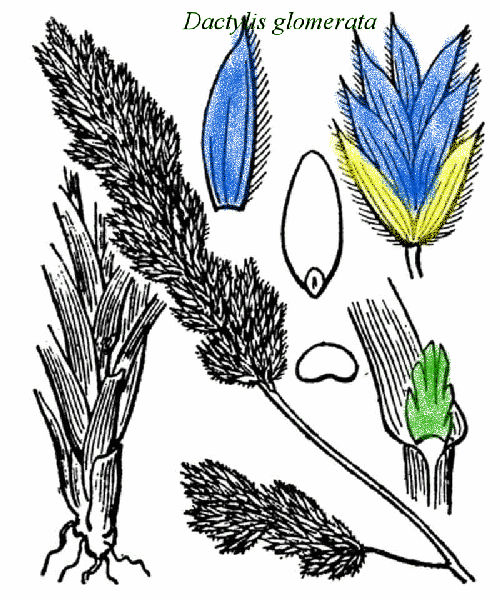
|
|
| or:- | Spikelets drooping and trembling |
Briza spp. : A & P.
Genus identified. Consult FlorMed or other flora to determine which species |
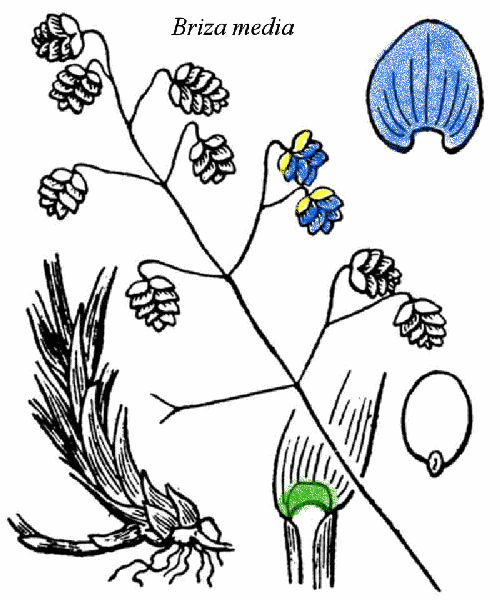
|
Group 9b |
Lemma or glumes with awns |
|||
| Either:- | Lemmas split/two-toothed with a subterminal awn; spikelet longer than 15 mm (without awns); leaf-sheaths (and often leaves) frequently velvety |
Bromus spp. (incl. Bromopsis, Ceratochloa and
Anisthanta): P.
Genus identified. but complex, with 15 species in our area
|
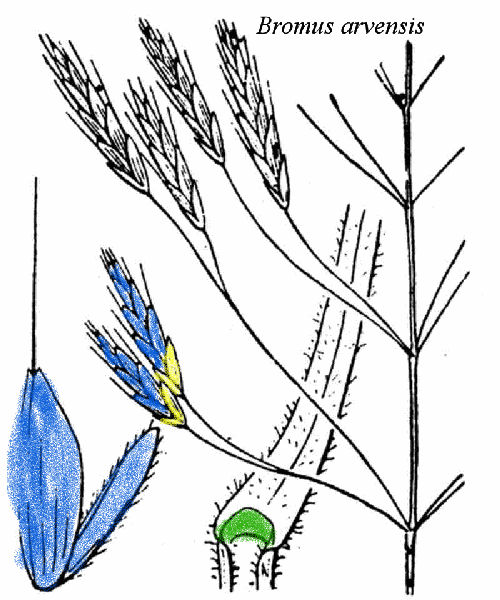
|
|
| or:- | Lemmas entire/toothed with a terminal awn (sometimes subterminal < 0.5 mm from the summit); spikelets compressed laterally; leaf-sheaths little or not compressed; lower glume > 2/3 upper glume. Basal leaves very narrow with the blade folded from the base, < 3.5 mm wide |
Festuca spp. (incl. Patzkia paniculata): P.
Genus identified. but complex, with 17 species in our area
|
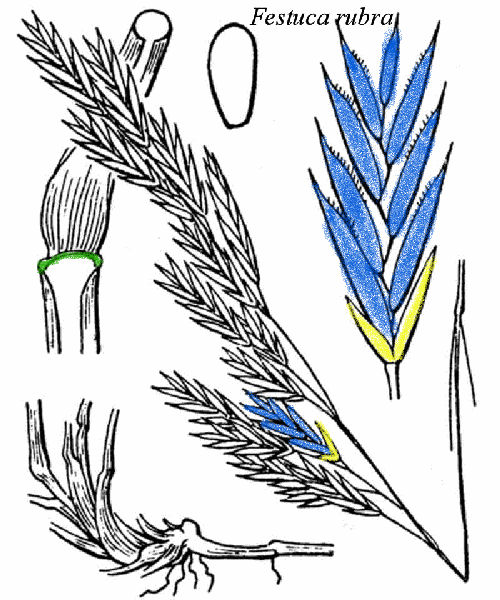
|
Group 9b Bromus subgroups |
Bromus species in FlorMed (15 in our area) : divided by TelaBotanica/FloraGallica (and thus Naturescene) in 4 genera: |
Bromus spp. (incl. Bromopsis, Ceratochloa and Anisthanta) Lemmas split/two-toothed with a subterminal awn; spikelet longer than 15 mm (without awns); leaf-sheaths (and often leaves) frequently velvety |
|
| Either:- | Lemmas bi-toothed, by less than 0.5 mm; lower glume with 1 vein |
Bromus subgroup Bromopsis(= Bromus subgenus Festucoides)
Subgroup identified
|
|
| or:- | Lemmas bi-toothed, by less than 0.5 mm; lower glume with several veins |
Bromus subgroup Ceratochloa(= Bromus subgenus Ceratochloa)
Subgroup identified
|
|
| or:- | Lemmas bi-toothed, by more than 0.5 mm; lower glume with several veins |
Bromus subgroup Bromus(= Bromus subgenus Bromus)
Subgroup identified
|
|
| or:- | Lemmas bi-toothed, by more than 0.5 mm; lower glume with 1 vein |
Bromus subgroup Anisthanta(= Bromus subgenus Stenobromus)
Subgroup identified
|
Group 9b Festuca subgroups |
Festuca species in FlorMed (14 in our area) are subdivided into 3 subgroups: |
Festuca spp. Lemmas entire/toothed with a terminal awn (sometimes subterminal < 0.5 mm from the summit); spikelets compressed laterally; leaf-sheaths little or not compressed; lower glume > 2/3 upper glume. Basal leaves very narrow with the blade folded from the base, < 3.5 mm wide |
||
| Either:- |
Base of plant swollen into a bulb, ligules 2-lobed, dense mat |
Patzkea paniculata ( = Festuca paniculata)Species identified. Congratulations |
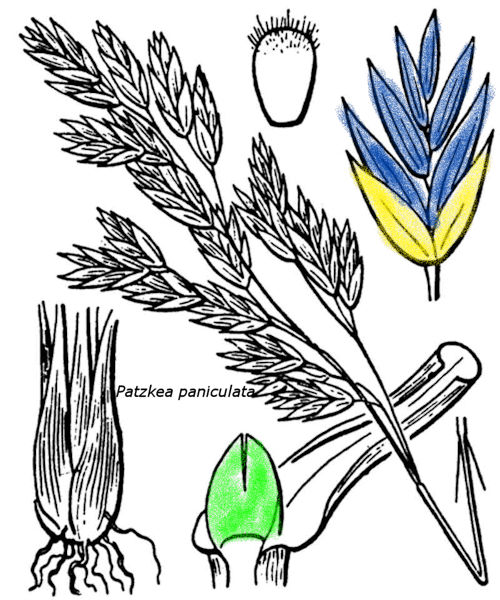
|
|
| or:- |
FlorMed subgroup 2Lemmas smooth or with a narrow membranous border; ligules <0.5 mm ; caryopsis adherent to the palea; flower-free shoots with leaf-sheaths fused right to the summit |
Festuca rubra, Festuca rivularis, Festuca nigrescens, Festuca
heteromalla, Festuca heterophylla
|
||
| or:- |
FlorMed subgroup 3Lemmas smooth or with a narrow membranous border; ligules <0.5 mm ; caryopsis adherent to the palea; flower-free shoots with leaf-sheaths fused for less than 2/3 of length |
Festuca valesiaca, Festuca marginata, Festuca filiformis,
Festuca ovina, Festuca airoides, Festuca heteroidea, Festuca
billyi, Festuca christiani-bernardii, Festuca auquieri, Festuca
longifolia, Festuca arvernensis
|
||
| or:- |
FlorMed subgroup 1Lemmas rough; ligules 1-7 mm ; caryopsis free |
This group in FlorMed is not present in our area |
Group 9c |
Lemma or glumes without awns (or at most a small point < 0.5 mm) |
|||
| Either:- |
Lemmas 7+ pronounced veins ; upper glumes with a single, slightly transparent vein |
Glyceria spp.: P
Genus identified. Consult FlorMed or other flora to determine which species |
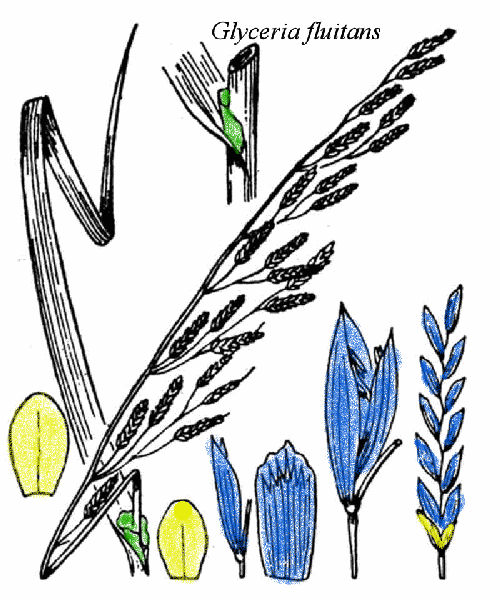
|
|
| or:- |
Lemmas with 3-5 veins ; upper glumes with 3+ veins |
Poa spp.: A & P.
Genus identified. Consult FlorMed or other flora to determine which species |
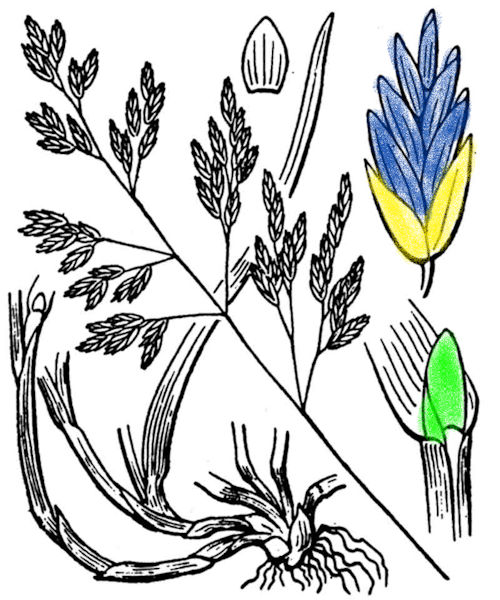
|
Groupe 9d |
Lemma or glumes without awns. Spikelets with a very short stalk, spike divaricate or unilateral |
|||
| Either:- |
Ligule oblong, torn |
Catapodium rigidum : A
Species identified. |
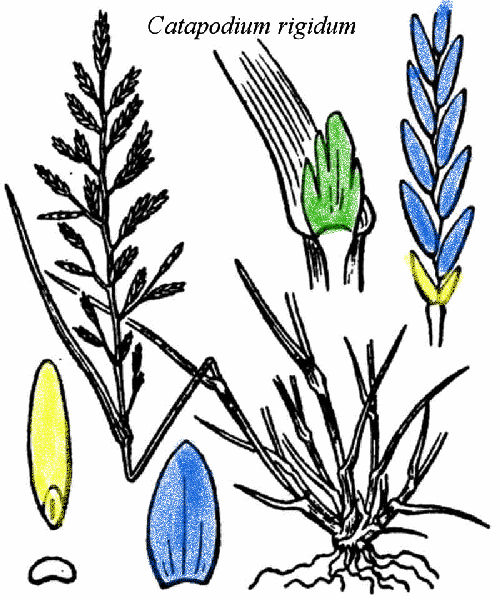
|
|
| or:- |
Ligule reduced to 2 lateral auricles, glabrous and fairly pointed |
Schedonurus pratense spp.: A & P.
Species identified. |
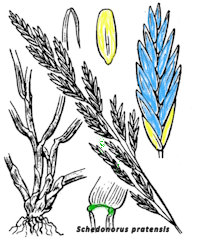
|
|
| or:- |
Ligule reduced to 2 lateral auricles, ciliated and fairly blunt |
Schedonurus arundinaceum spp.: A & P.
Species identified. |
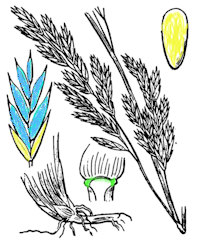
|
Whoops! Not a grass? Return to rushes and sedges!
-
Return to summary of groups
-
or Start again
THE END - I do hope you found what you were looking for